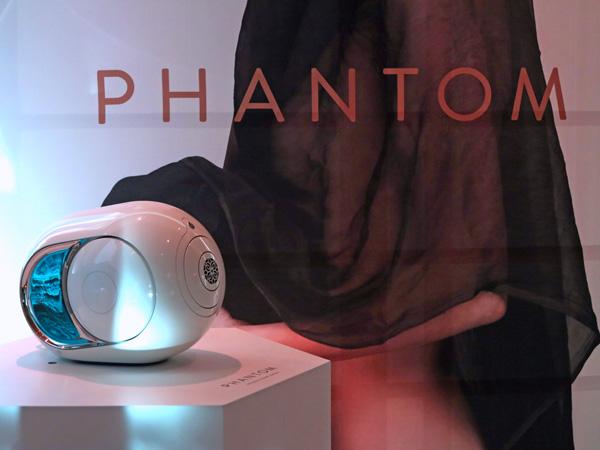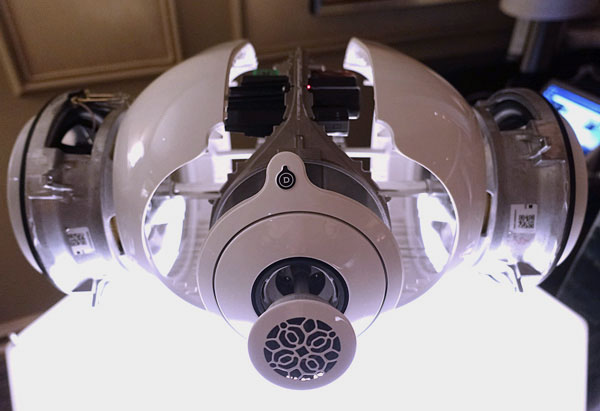| Columns Retired Columns & Blogs |
I would match the lights in the NFS Audio room.

Phantom reportedly takes advantage of "three major engineering inventions" involving 77 patents. (At one point, the literature says "close to 100 patents," but math does require a bit more precision that advertising hype.) An analog digital hybrid (ADH) "intelligence," directed by a powerful microprocessor, drives the Phantom's speaker. As explained to me by Devialet's Manuel de la Fuente, that means that a class-A analog amp sets the output voltage and drives the music, while four class-D amps, slaved to the master class-A amplifier, provide current in parallel. "This enables class-A to be more linear, with the lowest distortion on the market," he said. Speaker Active Matching (SAM) processing technology then controls the drive-units, "reproducing the exact acoustic pressure recorded by the microphone."
Second, the Phantom uses a unique "Heart Bass Implosion" system that produces "ultra deep" bass by high pressure beating of the unit's two lateral high-excursion bass driver "wings." Hence the similarity in appearance to the puffer fish that was swimming around in the huge aquarium behind the Mirage's registration desk in the lobby. In truth, the Phantom is far prettier, and, if its not turned on at ear-damaging levels while you're unwittingly standing right next to it, a lot more fun.
Lastly, the Phantom's spherical design creates a "homogenous sound no matter the listening angle." I can't vouch for that, because once this baby began pounding away, I realized that I needed to either capitulate and dance away, or bid adieu.
There was no way, in the middle of a crowded suite, to evaluate Devialet's claims that the Phantom has zero distortion, zero background noise, and zero saturation. Nor is there space to discuss everything laid out in the Phantom's white paper, including the nature of "Magic Wire" and claims of 16Hz–25kHz bandwith, ±2dB, 20Hz–20kHz bandwidth, ±0.5dB, and 105dB maximum SPL (the legal limit in clubs and live concerts).
Most important, there was no way to take a serious listen to classical music, jazz, or other acoustic music, and evaluate just how colorful, musical, and natural-sounding this baby can be. But there is no question that Phantom is a lot more fun than anything I've run into in the audio world in a very long time.
Phantom should net Devialet a fortune. It might even change how people listen to music. Units will ship in Europe on February 15, with prices set for €1390 for the standard 750W Phantom with 99dB peak volume, and €1690 for the Silver Phantom, which claims 2000W and 105dB peak volume. Projected arrival date in the US is March. There are other products in the line to discuss—a separate audio router Dialogue Box ($400) that synchronizes multiple units through their own networks, for example—but their time will come.
Robert Deutsch Comments: One of the products I was determined to seek out at CES was one that has created a lot of buzz on the Internet: the Devialet Phantom. I first read about it in a write-up by Michael Lavorgna on Audio Stream. It's a three-way powered loudspeaker, featuring the technology of the Devialet D/A integrated amp/DACs, with claimed frequency response extending to 20Hz. The Phantom was certainly impressive in a brief listen, playing very loud and with bass that would do credit to a subwoofer. While some of the claims for the Phantom are a little over-the-top ("The Phantom on its own will replace your stereo systems, speakers...it exceeds them at least 1000 times in terms of sound quality") it represents a technological tour de force, as you can see from the from the opened-up view below.


I would match the lights in the NFS Audio room.

Sound correction = Alternate sound. Probably the best ghettoblaster ever... Thumbs up for the marketing!

This looks intriguing... I'd like to see a Stereophile review when these become available. Though loudspeaker physics sure seems to suggest that these are too good to be true, I sure hope that they are.

Adding so much of "audio features" that at the end everybody understand it's marketing bullshit in a plastic box looking like first generation of Dyson just shows obviously that those people do not care about music.
Their amp was a good step of our industry, this stuff just shows they're lost !

I've had this at home for a weekend (purchased in London and shipped to the US.)
My initial impression is that it takes the boombox to a whole new level. I only bought one, so I don't hear any soundstage. It's set up in a large room with my older stereo system - a Thorens turntable T+A integrated CD player/amp, and ProAc Response 5 speakers.
In ease and convenience, the Phantom wins hands down. It sits on a bookshelf and connects wirelessly with my computer; very easy setup and use.
Comparing the two setups sonically is difficult. The Phantom goes considerably louder and considerably deeper than the older setup, even at a tiny fraction of the size (the ProAcs are large floor standers, but were never famous for deep bass.) Even at low levels the bass is remarkable, giving the music a sense of solidity and foundation that's different from feeling you get from the stereo illusion of soundstage.
I haven't yet set up the Dialog router, and without it you can only play music you happen to have locally. I listened to choral music, jazz, some contemporary Jordanian rock, and Santana's Abraxis. It worked extremely well on everything.
I'm not sure if I'd prefer this thing to a high end two channel system for dedicated listening, but for background, party, or dance music, I've never heard anything remotely like it.

Its a clever design; point source, no diffraction with those curves.. I cd go on. I'd love to see a breakdown of the midrange driver. I wonder if they'll make a larger speaker design next?